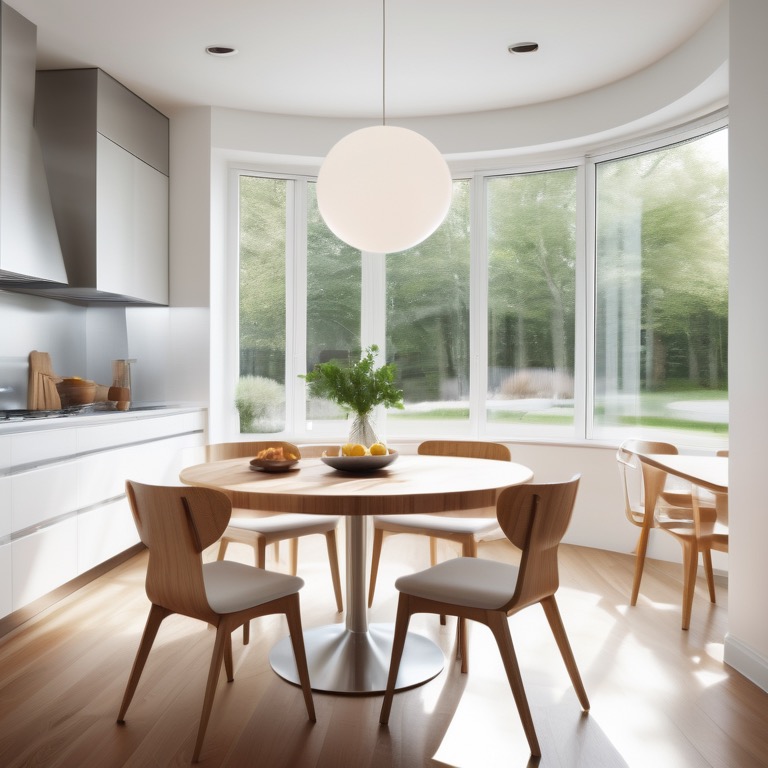Kitchen Tables: Round or Square?

Kitchen Tables: Round or Square?
The essence of selecting a dining table for your home goes beyond simply finding a table that matches your decor. It's about understanding how you plan to utilise the space, and evaluating the table's form and function. When it comes to choosing between round, square, or rectangle tables, it's crucial to understand their respective merits and which will align best with your lifestyle and room layout (space efficiency, dining habits, and aesthetics). This guide offers detailed insights into the benefits and drawbacks of each of these table shapes, aiming to make your decision-making process smoother and more informed. Additionally, we will discuss the importance of choosing the right dining table shape for your specific needs.
Why Round or Square Kitchen Tables?
Round or square tables offer a range of advantages that merit their consideration. They both foster a sense of warmth and intimacy by ensuring equal access to everyone seated due to the absence of a defined head of the table. Their compact size makes them ideal for smaller dining areas like apartments or studio flats, where space optimisation is crucial. Moreover, their versatile aesthetics allow them to blend seamlessly into various design schemes.
Comparing Round and Square Kitchen Tables
When comparing round and square kitchen tables, the decision ultimately rests upon your space availability, dining needs, and personal preferences. Are you trying to maximise a small area, or do you have a large family and require extra seating capacity? Do you prefer the soft curves of a round table or the symmetrical geometry of a square table? Understanding the advantages of each style will assist you in making an informed decision that best accommodates your dining requirements without compromising on aesthetics or comfort in your dining room.
Space Requirements
Here's a comparison of the space requirements of round and square tables:
Round: A round table often requires less space due to its lack of corners, allowing more flexibility in placement within the room.
Square: A square table is best suited for rooms with equal dimensions. It can sit neatly in corners or be positioned centrally, depending on the room's layout
Seating Capacity
The seating capacity of the table depends largely on the size of the table. Generally, a small-to-medium-round dining table can comfortably accommodate 2-6 people, while larger round tables can seat up to 12 diners. However, square tables, due to their straight edges, can often host 4-8 people comfortably, depending upon their size. If you frequently entertain large groups, it may be beneficial to opt for an extendable design, such as an extendable dining table, or a larger rectangular table.
Functionality and Comfort
Round and square tables both offer distinctive functionality and comfort. Round tables are renowned for their ability to foster intimate gatherings and promote conversations, making them a popular choice for dinner parties. Square tables, on the other hand, provide a balanced, equal seating arrangement, perfect for family dinners or sales board games evenings.
Aesthetics and Design
Visually, both round and square tables offer their unique charm. Round tables, with their soft curves, create a cosy, informal vibe, while enhancing the room's flow and movement. Square tables, in contrast, bring symmetry, order, and a sense of formality to a room, making them ideal for more structured, formal dining settings. However, oval dining tables provide the best of both worlds, combining the softness of a round table with the formality of a square table, making them a versatile option for various decor styles.
Flexibility in Layout and Room Arrangement
Round tables can be placed anywhere in the room without disrupting its flow and can accommodate extra chairs when needed. They are especially practical in open floor plans where distinct separation of areas is not required. Square tables, on the other hand, work best in rooms with equal dimensions or rooms that require a clear definition of space, like in open-plan spaces. Additionally, square tables are also suitable for larger gatherings, as they can comfortably accommodate both small and large groups. This flexibility in layout and room arrangement makes them a popular choice for any dining room.
Advantages of Round Kitchen Tables
Considered versatile furnishings, round kitchen tables bring a range of benefits. These tables offer efficient use of space, foster intimate gatherings and social interaction, provide safety for younger children due to absence of sharp corners, and facilitate ease of serving and passing food during meals. Their well-rounded merits make them a popular choice, especially for homes operating on a 'cosy living' ethos. For families with young children, a small round dining table can also be added near the main table, serving as a designated kids' table during family gatherings and making cleaning up easier.
Encouraging Conversations
One of the standout advantages of round tables is their ability to encourage conversation. The equal distance between all diners eliminates the typical head-of-the-table setup, creating an equal seating arrangement. This fosters a more democratic and intimate atmosphere, prompting inclusive interaction among everyone at the table.
Enhancing the Visual Appeal
Round tables, with their symmetrical shape and smooth edges, can significantly enhance the visual appeal of a dining area. They create a focal point in the room and add a certain elegance and poise. Plus, the option to choose from an array of designs and materials allows homeowners to find a table that aligns perfectly with their interior design aesthetic.
Maximising Small Spaces
Round tables are particularly well-suited for small spaces due to their compact dimensions and absence of corners. They make efficient use of available space, making the room feel more open and less cramped. Furthermore, they can be easily positioned anywhere in the room, from the centre to the nook, and still maintain their appeal and functionality.
Advantages of Square Kitchen Tables
Square kitchen tables, while marginally limited in seating capacity compared to round or rectangular options, offer a host of advantages. From providing a balance and symmetry, promoting equal-distance seating, to naturally fitting into square-shaped rooms and offering additional guest accommodation; these tables are a perfect blend of aesthetics, function, and practicality.
Symmetry and Straight Lines
A significant advantage of square tables is the sense of balance and order they create, thanks to their symmetry and straight lines. This lends a degree of formality and sophistication to a room, making the dining experience more structured and organised. For those who appreciate order and formality, a square table is an attractive choice.
Accommodating Additional Guests
With its four equal sides, a square table can easily accommodate an extra guest at each corner when needed. This ability to expand its seating capacity makes it a versatile choice for both daily use and occasional gatherings, particularly when paired with additional seating such as benches or stools.
Versatility in Placement
Square tables hold an upper hand in versatility when it comes to placement within a room, whether it be a dining room or living room. They can be neatly slotted into corners or huddled against a wall, freeing up floor space. In larger rooms, they can be placed centrally to define the dining area distinctly, making them a highly adaptable furniture piece. Additionally, square tables can also be used in the living room as coffee tables, side tables, or even as a console table behind a sofa. This versatility makes them a valuable addition to any living room.
Choosing a Kitchen Table Based on Room and Personal Preferences
Choosing between a round or square table involves careful consideration of several factors such as the room's size, layout, your usual number of diners, desired aesthetics, and personal preferences. Evaluating these factors will aid in selecting the right shape that serves your practical needs and adds value to your dining setup. Make sure to leave enough room for diners to pull out chairs, move around, and access the table easily without feeling cramped.
Evaluating the Room's Shape
The room's shape plays a vital role in choosing the table shape. Narrow rooms or spaces with one large open wall pair well with rectangular tables, while square rooms generally look best with a square or round table. Open floor layouts provide flexibility to choose any shape depending on the other factors, including the addition of dining chairs for extra seating.
Assessing Your Dining Needs
Number of diners, frequency of inviting guests, and your dining style should determine the shape of the dining table. A large family might prefer a rectangular table for its high seating capacity, while a round table is better for encouraging conversations and eliminating a defined head for those who frequently host dinner parties. Assessing your seating needs is crucial when deciding on the shape of the dining table.
Balancing Style and Function
Finally, striking a balance between style and function is key when choosing a dining table. While you want a table that complements your home's aesthetics, it's equally important to consider the functionality it offers. Round tables bring in elegance and intimacy, while square tables provide structure and formality—choose what suits your personal style and needs the best.
Choosing between a round or square kitchen table boils down to a combination of your personal preferences, dining needs, and the layout of your room. Both shapes offer their unique set of advantages. Round tables, known for encouraging comprehensive interaction and fostering a cosier ambiance, are often the perfect choice for smaller spaces and intimate gatherings. On the other hand, square tables surely hold their ground with equality in seating arrangement, space efficiency, and a sense of formality they bring to a room. Prioritising these will indeed steer you towards the perfect choice, ensuring that every meal you share on your round or square kitchen table becomes a cherished memory.
